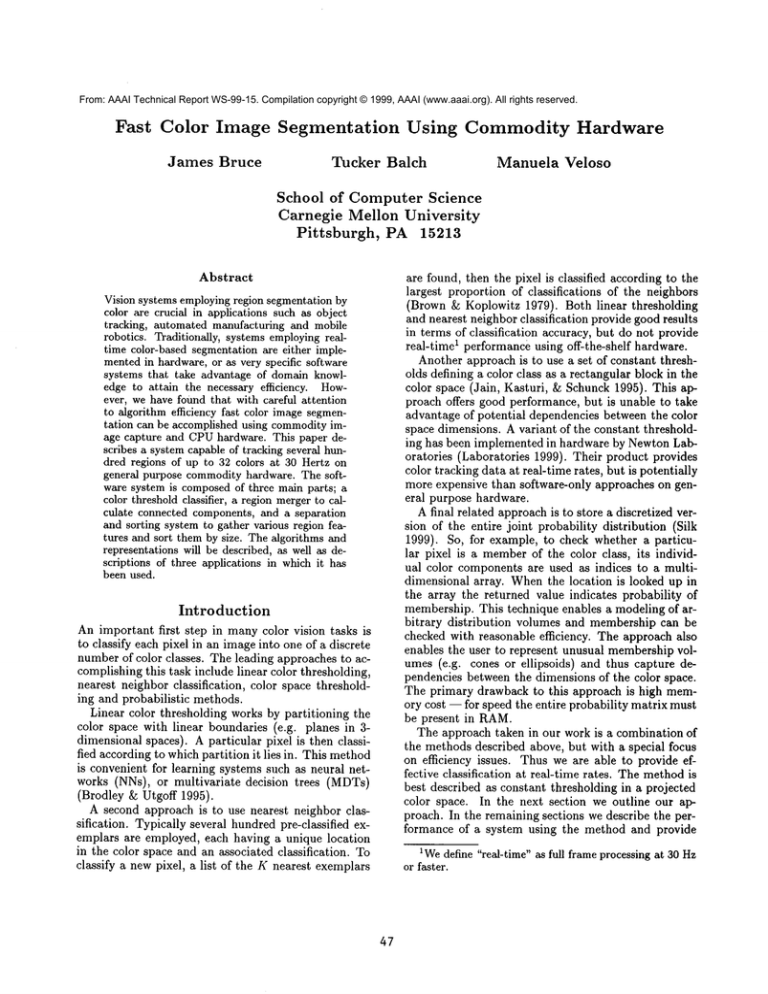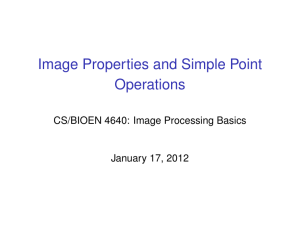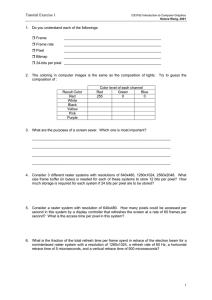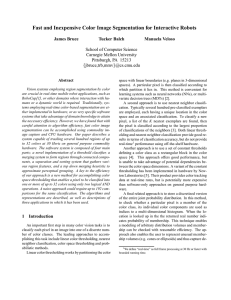
From: AAAI Technical Report WS-99-15. Compilation copyright © 1999, AAAI (www.aaai.org). All rights reserved.
Fast
Color
James
Image Segmentation
Bruce
Tucker
Using
Balch
Commodity Hardware
Manuela
Veloso
School
of Computer
Science
Carnegie
Mellon
University
Pittsburgh,
PA 15213
Abstract
Vision systems employingregion segmentation by
color are crucial in applications such as object
tracking, automated manufacturing and mobile
robotics. Traditionally, systems employingrealtime color-based segmentation are either implementedin hardware, or as very specific software
systems that take advantage of domain knowledge to attain the necessary efficiency. However, we have found that with careful attention
to algorithm efficiency fast color image segmentation can be accomplishedusing commodityimage capture and CPUhardware. This paper describes a systemcapable of tracking several hundred regions of up to 32 colors at 30 Hertz on
general purpose commodityhardware. The software system is composedof three main parts; a
color threshold classifier, a region mergerto calculate connected components, and a separation
and sorting systemto gather various region features and sort them by size. The algorithms and
representations will be described, as well as descriptions of three applications in which it has
been used.
Introduction
An important first step in many color vision tasks is
to classify each pixel in an image into one of a discrete
number of color classes. The leading approaches to accomplishing this task include linear color thresholding,
nearest neighbor classification, color space thresholding and probabilistic methods.
Linear color thresholding works by partitioning the
color space with linear boundaries (e.g. planes in 3dimensional spaces). A particular pixel is then classified according to which partition it lies in. This method
is convenient for learning systems such as neural networks (NNs), or multivariate decision trees (MDTs)
(Brodley & Utgoff 1995).
A second approach is to use nearest neighbor classification. Typically several hundredpre-classified exemplars are employed, each having a unique location
in the color space and an associated classification. To
classify a new pixel, a list of the K nearest exemplars
are found, then the pixel is classified according to the
largest proportion of classifications of the neighbors
(Brown & Koplowitz 1979). Both linear thresholding
and nearest neighbor classification provide good results
in terms of classification accuracy, but do not provide
real-time 1 performance using off-the-shelf hardware.
Another approach is to use a set of constant thresholds defining a color class as a rectangular block in the
color space (Jain, Kasturi, & Schunck 1995). This approach offers good performance, but is unable to take
advantage of potential dependencies between the color
space dimensions. A variant of the constant thresholding has been implemented in hardware by Newton Laboratories (Laboratories 1999). Their product provides
color tracking data at real-time rates, but is potentially
more expensive than software-only approaches on general purpose hardware.
A final related approach is to store a discretized version of the entire joint probability distribution (Silk
1999). So, for example, to check whether a particular pixel is a memberof the color class, its individual color components are used as indices to a multidimensional array. Whenthe location is looked up in
the array the returned value indicates probability of
membership. This technique enables a modeling of arbitrary distribution volumes and membership can be
checked with reasonable efficiency. The approach also
enables the user to represent unusual membershipvolumes (e.g. cones or ellipsoids) and thus capture dependencies between the dimensions of the color space.
The primary drawback to this approach is high memory cost -- for speed the entire probability matrix must
be present in RAM.
The approach taken in our work is a combination of
the methods described above, but with a special focus
on efficiency issues. Thus we are able to provide effective classification at real-time rates. The methodis
best described as constant thresholding in a projected
color space. In the next section we outline our approach. In the remaining sections we describe the performance of a system using the method and provide
1Wedefine "real-time" as full frameprocessing at 30 Hz
or faster.
examples of the system in use in several applications.
Description
of the Approach
Color Space Transformation
Our approach involves the use of thresholds in a a three
dimensional color space. Several color spaces are in
wide use, including Hue Saturation Intensity (HSI),
YUVand Red Green Blue (RGB). The choice of color
space for classification depends on several factors including which is provided by the digitizing hardware
and utility for the particular application.
RGBis a familiar color space often used in image
processing, but it suffers from an important drawback
for manyrobotic vision applications. Consider robotic
soccer for instance, where features of the environment
are markedwith identifying colors (e.g. the ball might
be painted orange). Wewould like our classification
software to be robust in the face of variations in the
brightness of illumination, so it wouldbe useful to define "orange" in terms of a ratio of the intensities of
Red Green and Blue in the pixel. This can be done in
an RGBcolor space, but the volume implied by such
a relation is conical and cannot be represented with
simple thresholds.
In contrast, HSI and YUVhave the advantage that
chrominance is is coded in two of the dimensions (H
and S for HSI or U and V for YUV)while intensity
is coded in the third. Thus a particular color can be
described as "column" spanning all intensities. These
color spaces are therefore often more useful than RGB
for robotic applications.
Somedigitizing hardware provides one or more appropriate color spaces directly (such as HSI or YUV).
In other cases, the space may require transformation
from the one provided by hardware to something more
appropriate. Once a suitable projection is selected,
the resulting space can be partitioned using constant
valued thresholds, since most of the significant correlations have been removed.
The commodity digitizer we used provides images
coded in RGB. We found that rotating
the RGB
color space provides significantly more robust tracking. Muchof the information in an RGBimage varies
along the intensity axis, which is roughly the bisecting
ray of the three color axes. By calculating the intensity and subtracting this component from each of the
color values, a space in whichthe variance lies parallel
to the axes is created, allowing a more accurate representation of the region space by a rectangular box.
Another, more robust (but more expensive) transformation is a nonlinear fractional RGBspace, where
each of the componentcolors is specified as a fraction
of the intensity, and the intensity is added as another
dimension. This projection into a 4 dimensional space
proved accurate, but with the extra dimension to process and three divides per pixel to calculate the fractions, it proved to be too slow for currently available
hardware.
48
Thresholding
In our approach, each color class is specified as a set
of six threshold values: two for each dimension in the
transformed color space (for purposes of discussion we
will use the YUVspace). The mechanism used for
thresholding is an important efficiency consideration
because the thresholding operation must be repeated
for each color for each pixel in the image. One way to
check if a pixel is a memberof a particular color class
is to use a set of comparisonssimilar to
if ((Y >= Ylowerthresh)
AND(Y <= Yupperthresh)
AND(U >= Ulowerthresh)
AND(U <= Uupperthresh)
AND(V >--Vlowerthresh)
AND(V <= Vupperthresh))
pixel_color
-- color_class;
to determine if a pixel with values Y, U, V should
be grouped in the color class. Unfortunately this approach is rather inefficient because, once compiled, it
could require as manyas conditional branches to determine membershipin one color class for each pixel.
This can be especially inefficient on pipelined processors with speculative instruction execution.
Instead, our implementation uses a boolean valued decomposition of the multidimensional threshold.
Such a region can be represented as the product of
three functions, one along each of the axes in the space
Figure 1). The decomposed representation is stored
n arrays, with one array element for each value of a
color component. Thus class membership can be computed as the bitwise ANDof the elements of each array
indicated by the color component values:
pixel_in_class
= YClass[Y]
ANDUClass
[U]
AND VClass
IV];
The resulting
booleanvalueof pixel_in_class
indicateswhether the pixel belongs to the class or not.
This approach allows the system to scale linearly with
the number of pixels and color space dimensions, and
can be implemented as a few array lookups per pixel.
The operation is much faster than the naive approach
because the the bitwise ANDis a significantly lower cost
operation than an integer compare on most modern
processors.
To illustrate the approach, consider the following example. Suppose we discretize the YUVcolor space to
10 levels in each each dimension. So "orange," for example might be represented by assigning the following
values to the elements of each array:
YClass[] = {0,1,1,1,1,1,1,1,1,1};
UClass[]
= {0,0,0,0,0,0,0,i,i,i};
I/Class[]
= {0,0,0,0,0,0,0,1,1,1};
Thus, to check if a pixel with color values (1,8,9)
a memberof the color class "orange" all we need to do
is evaluate the expression YClass [1] ANDUClass [8]
ANDVClass [9], which in this case would resolve to 1,
or true indicating that color is in the class "orange."
One of the most significant advantages of our approach is that it can determine a pixel’s membership
YClassl
I
Y
UClassl
VClassI
I
Iu
I
v
I
BinarySignalDecomposition
of Threshold
Y
Visualization
as Threshold
in Full ColorSpace
Figure 1: A three-dimensional region of the color space for classification
binary functions.
in multiple color classes simultaneously. By exploiting
parallelism in the bit-wise AND
operation for integers we
can determine membership in several classes at once.
As an example, suppose the region of the color space
occupied by "blue" pixels were represented as follows:
YClass[]
= {0,1,1,1,1,1,1,1,1,1};
UClass[]
= {i,I,I,0,0,0,0,0,0,0};
VClass[]
= {0,0,0,I,I,I,0,0,0,0};
Rather than build a separate set of arrays for each
color, we can combine the arrays using each bit position an array element to represent the corresponding
values for each color. So, for example if each element
in an array were a two-bit integer, we could combine
the "orange" and "blue" representations as follows:
YClass[] = {00,11,11,11,11,11,11,11,11,11};
UClass[] -- {01,01,01,00,00,00,00,10,10,10};
YClass[] = {00,00,00,01,01,01,00,10,10,10};
Wherethe first (high-order) bit in each element is used
to represent "orange" and the second bit is used to represent "blue." Thus we can check whether (1,8,9)
in one of the two classes by evaluating the single expression YClass[i] AND UClass[8] AND VClass[9].
The result is 10, indicating the color is in the "orange"
class but not "blue."
In our implementation, each array element is a 32bit integer. It is therefore possible to evaluate membership in 32 distinct color classes at once with two
ANDoperations. In contrast, the naive comparison approach could require 32 x 6, or up to 192 comparisons
for the same operation. Additionally, due to the small
size of the color class representation, the algorithm can
take advantage of memorycaching effects.
Connected
Regions
After the various color samples have been classified,
connected regions are formed by examining the classified samples. This is typically an expensive opera-
49
is represented as a combination of three
tion that can severely impact real-time performance.
Our connected components merging procedure is implemented in two stages for efficiency reasons.
The first stage is to compute a run length encoded
(RLE)version for the classified image. In manyrobotic
vision applications significant changes in adjacent image pixels are relatively infrequent. By grouping similar adjacent pixels as a single "run" we have an opportunity for efficiency because subsequent users of the
data can operate on entire runs rather than individual
pixels. There is also the practical benefit that region
merging need now only look for vertical connectivity,
because the horizontal components are merged in the
transformation to the RLEimage.
The merging method employs a tree-based union
find with path compression. This offers performance
that is not only good in practice but also provides a
hard algorithmic bound that is for all practical purposes linear (Tarjan 1983). The merging is run
place on the classified R.LE image. This is because
each run contains a field with all the necessary information; an identifier indicating a run’s parent element
(the upper leftmost memberof the region). Initially,
each run labels itself as its parent, resulting in a completely disjoint forest. The merging procedure scans
adjacent rows and merges runs which are of the same
color class and overlap under four-connectedness. This
results in a disjoint forest where the each run’s parent
pointer points upward toward the region’s global parent. Thus a second pass is needed to compress all of
the paths so that each run is labeled with its the actual
parent. Noweach set of runs pointing to a single parent uniquely identifies a connected region. The process
is illustrated in Figure 2).
1: Runsstart as a fully disjoint forest
2: Scanningadjacent lines, neighborsare merged
3: Newparent assignmentsare to the furthest parent
4: If overlapis detected,latter parentis updated
Figure 2: An example of howregions are grouped after run length ’encoding.
Extracting
Region
Information
In the final step we extract region information from
the merged RLE map. The bounding box, centroid,
and size of the region are calculated incrementally in
a single pass over the forest data structure. Because
the algorithm is passing over the image a run at a time,
and not processing a region at a time, the region labels
are renumberedso that each region label is the index of
a region structure in the region table. This facilitates
a faster lookup. A number of other statistics
could
easily be gathered from the data structure, including
the convex hull and edge points which could be useful
for geometric model fitting.
After the statistics have been calculated, the regions
are separated based on color into separate threaded
linked lists in the region table. Finally, they are sorted
by size so that high level processing algorithms can
deal with the larger (and presumably more important)
blobs and ignore relatively smaller ones which are most
often the result of noise.
Results
and Applications
The first implementation is a proof-of concept prototype targeted for small inexpensive autonomous
robots. These robots will employ commodity hardware to keep the cost low and aid in simplicity. They
still require high performance vision however because
it will serve as their primary hazard sensor. The platform uses a conventional NTSCcolor camera linked to
a Pentium-based PC-104 computer and a BTTV848based digitizer.
Operating software is RedHat Linux
Figure 3: An example image classified using the approach presented in the paper. The image on the left
is a composite of objects tracked by a soccer robot
at RoboCup-99: a position marker (top), a goal area
(middle) and three soccer balls (bottom). The classified image is on the right.
5O
with Video for Linux drivers for video capture. In its
current form the system can process 160x120images at
30 Hz with 50% utilization
of the 150 MHzCPU. We
have since discovered that the digitizer can capture images in YUVspace directly. It is therefore possible to
eliminate the color space transformation step. When
the transformation step is eliminated the system processes 160x120 images at 30 Hz with a 25%utilization
of the CPU.
The second successful application was for Carnegie
Mellon’s entry into the RoboCup-99 legged-robot
league.
These robots, provided by Sony, are
quadrupeds similar to the commercially available Aibo
entertainment robot. The robots play a game of three
versus three soccer against other teams in a tournament. To play effectively,
several objects must be
recognized and processed, including the ball, teammates and opponents, two goals, and 6 location markers placed around the field. The hardware includes
a camera producing 88x60 frames in the YUVcolor
space at about 15Hz. In this application color classification is done in hardware, removing the need for this
step in the software system. Even with one step of the
algorithm handled in software however, limited computational resources require an optimized algorithm in
order to leave time for higher-level processes like motion control, team behaviors, and localization. The
system was modified slightly to include density based
region merging to overcome excessively noisy images
that simple connectivity could not handle. The system
proved to be robust at the RoboCup-99 competition,
enabling our team to finish 3rd in the international
competition.
The third application of the system is as part of an
entry for the RoboCupsmall-size league (F180). This
domain involves a static camera tracking remotely controlled robots playing soccer on a small field. It is
currently being incorporated into a system under development for the competition in 2000. Due to recent developments in mechanical platforms the level of
competition in this league has increased significantly.
To compete with current state-of-the-art
systems vision must be able to track 11 objects moving at up
to 2 meters/second at full frame rates. Our system
is able to process 320x240 color frames at 30Hz on
a 200 MHzPentium II. In this mode the vision system uses approximately 45% of the available CPUresources. 160x120 pixel images can be processed at
30 Hz using only 12% of the CPU. These results indicate that the system will operate with lower processor utilization than previous implementations, providing more resources for higher level operations. These
should both contribute to the robustness of the overall
tracking system.
Conclusion
Wehave presented a new system for real-time segmentation of color images. It can classify each pixel in
51
a 320x240 color image, find and merge blobs of up
to 32 colors, and report their centroid, bounding box
and area at 30 Hz. The primary contribution of this
system is that it is a software-only approach implemented on general purpose, inexpensive, hardware (in
our case a Pentium II 200 MHzprocessor with a $200
image digitizer). This provides a significant advantage
over more expensive hardware-only solutions, or other,
slower software approaches.
The system operates on the image in several steps:
1. Rotate the color space.
2. Classify each pixel as one of up to 32 colors.
3. Run length encode each scanline according to color.
4. Group runs of the same color into blobs.
5. Sort blobs by color and size.
6. Return blob statistics.
The speed of our approach is due to a focus on efficient
algorithms at each step. Step 1 is accomplished with
a linear transformation. In Step 2 we discard a naive
approach that would require up to 192 comparisons
per pixel in favor of a faster calculation using two bitwise ANDoperations. Step 3 is linear in the number of
pixels. Step 4 is accomplishedusing an efficient union
find algorithm. The sorting in Step 5 is accomplished
with radix sort, while Step 6 is completed in a single
pass over the resulting data structure.
The approach is intended primarily to accelerate
low level vision for use in reM-time applications where
hardware acceleration is either too expensive or unavailable. Functionality is appropriate to provide input to higher level routines which encode geometric
and/or domain-specific processing. This tool enables
formerly offiine processes to run as a part of a real-time
intelligent vision system. The current system and its
variants have been demonstrated successfully on three
hardware platforms.
References
Brodley, C., and Utgoff, P. 1995. Multivariate decision trees. Machine Learning.
Brown, T., and Koplowitz, J. 1979. The weighted
nearest neighbor rule for class dependent sample sizes.
IEEE Transactions on Information Theory 617-619.
Jain, R.; Kasturi, R.; and Schunck, B. 1995. Machine
Vision. McGraw-Hill.
Laboratories, N. 1999. Cognachrome image capture
device,
http://www.
newtonlabs,
com.
Silk,E. 1999.Humandetection
and recognition
for
an
hors
d’oeuvres
serving
robot.
http://www.cs. swarthmore,
edu/silk/robot/.
Tarjan, R. 1983. Data structures and network algorithms. In Data Structures and Network Algorithms.






